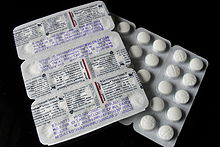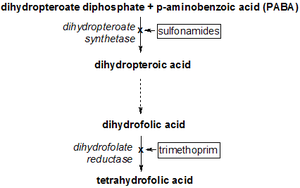- Trimethoprim/sulfamethoxazole
-
Trimethoprim/sulfamethoxazole Combination of Trimethoprim Dihydrofolate reductase inhibitor (16.7%) Sulfamethoxazole Sulfonamide antibiotic (83.3%) Clinical data Trade names Bactrim, Bactrimel, Biseptol, Co-trimoxazole, Cotrim, Septrin, Septra, Sulfatrim, Trisul Pregnancy cat. C(AU) C(US) Legal status ℞-only (US) Routes Oral Identifiers CAS number 8064-90-2 ATC code J01EE01 PubChem CID 358641 ChemSpider 318412  (what is this?) (verify)
(what is this?) (verify)Trimethoprim/sulfamethoxazole or Co-trimoxazole (abbreviated SXT, TMP-SMX, TMP-SMZ or TMP-sulfa) is a sulfonamide antibiotic combination of trimethoprim and sulfamethoxazole, in the ratio of 1 to 5, used in the treatment of a variety of bacterial infections.
The name co-trimoxazole is the British Approved Name, and has been marketed worldwide under many trade names including Septra (GSK), Bactrim (Roche), and various generic preparations. Sources differ as to whether co-trimoxazole usually is a bactericide or a bacteriostatic agent.
Contents
Clinical indications
Co-trimoxazole was claimed to be more effective than either of its components individually in treating bacterial infections, although this was later disputed.[1] Along with its associated greater incidence of adverse effects including allergic responses (see below), its widespread use has been restricted in many countries to very specific circumstances where its improved efficacy is demonstrated.[2] It may be effective in a variety of upper and lower respiratory tract infections, renal and urinary tract infections, gastrointestinal tract infections, skin and wound infections, septicaemias and other infections caused by sensitive organisms. The global problem of advancing antimicrobial resistance has led to a renewed interest in the use of co-trimoxazole in various settings more recently.[3]
The current British Committee on Safety of Medicines (CSM) guidelines recommend limiting its use to:[citation needed]
- Pneumocystis pneumonia
- Toxoplasmosis and nocardiosis
- Acute exacerbations of chronic bronchitis and infections of the urinary tract where there is good rationale for use
- Acute otitis media in children where there is good rationale
Specific indications for its use include:
HIV
Being an antibiotic, co-trimoxazole does not have any activity against HIV itself, but it is often prescribed to immunocompromised patients as Pneumocystis jirovecii pneumonia prophylaxis.
Bacterial
- infections caused by Listeria monocytogenes, Nocardia spp., Stenotrophomonas maltophilia (Zanthomonas maltophilia)
- Staphylococcus saprophyticus infections presenting as urinary tract infection or cystitis
- Susceptible strains of Escherichia coli
- melioidosis
- shigellosis
- Whipple's disease
- traveler's diarrhea
- Acne vulgaris
Protozoan
- Isosporiasis[4]
- prophylaxis of cerebral toxoplasmosis in HIV patients
- Cyclospora cayetanensis
Fungal
- treatment and prophylaxis of pneumonia caused by Pneumocystis jirovecii (formerly identified as P. carinii and commonly seen in immunocompromised patients including those suffering from cancer or HIV/AIDS)
Side effects
There has been some concern about its use, however, since it has been associated with both frequent mild allergic reactions and serious adverse effects, including Stevens-Johnson syndrome, myelosuppression, mydriasis, agranulocytosis, and severe liver damage (cholestatic hepatosis, hepatitis, liver necrosis, and fulminant liver failure).[citation needed] Due to displacement of bilirubin from albumin, there is an increased risk of kernicterus in the fetus during the last six weeks of pregnancy. Also, renal impairment up to acute renal failure and anuria have been reported. These side effects are seen especially in the elderly and may be fatal. (Joint Formulary Committee, 2004). Both folic acid and folinic acid were found equally effective in reducing the adverse effects of TMP-SMX, so unless new evidence is found for folinic acid that shows it is more effective than the cheaper folic acid, the latter will continue to be the preferred treatment method.
Trimethoprim/sulfamethoxazole may have the following adverse reactions:[5]
- Allergic – Stevens–Johnson syndrome, toxic epidermal necrolysis, anaphylaxis, allergic myocarditis, erythema multiforme, exfoliative dermatitis, angiodema, drug fever, chills, Henoch–Schönlein purpura, serum sickness-like syndrome, generalized allergic reactions, generalized skin eruptions, photosensitivity, conjunctival and scleral injection, pruritus, urticaria and rash. In addition, periarteritis nodosa and systemic lupus erythematosis have been reported.
- Endocrine – The sulfonamides bear certain chemical similarities to some goitrogens, diuretics (acetazolamide and the thiazides), and oral hypoglycemic agents. Cross-sensitivity may exist with these agents. Diuresis and hypoglycemia have occurred rarely in patients receiving sulfonamides.
- Gastrointestinal – Hepatitis, including cholestatic jaundice and hepatic necrosis, elevation of serum transaminase and bilirubin, pseudo-membranous enterocolitis, pancreatitis, stomatitis, glossitis, nausea, emesis, abdominal pain, diarrhea, anorexia.
- Genitourinary – Renal failure, interstitial nephritis, BUN and serum creatinine elevation, toxic nephrosis with oliguria and anuria, and crystalluria.
- Hematologic – Agranulocytosis, aplastic anemia, thrombocytopenia, leukopenia, neutropenia, hemolytic anemia, megaloblastic anemia, hypoprothrominemia, methemoglobinemia, eosinophilia.
- Metabolic – Hyperkalemia, hyponatremia.
- Musculoskeletal – Arthralgia and myalgia.
- Neurologic – Aseptic meningitis, convulsions, peripheral neuritis, ataxia, vertigo, tinnitus, headache.
- Psychiatric – Hallucinations, depression, apathy, nervousness.
- Respiratory System – Cough, shortness of breath, and pulmonary infiltrates.
- Miscellaneous – Weakness, fatigue, insomnia.
Mechanism of action
The synergy between trimethoprim and sulfamethoxazole was first described in a series of in vitro and in vivo experiments published in the late 1960s.[6][7][8] Trimethoprim and sulfamethoxazole have a greater effect when given together than when given separately; the reason is because they inhibit successive steps in the folate synthesis pathway (see diagram below).
It is unclear whether this synergy occurs at doses used in humans,[9] because, at the concentrations seen in blood and tissues, the ratio of trimethoprim to sulfamethoxazole is 1:20,[10] which is less than the 1:5 ratio needed in vitro for synergy to occur.
Sulfamethoxazole acts as a false-substrate inhibitor of dihydropteroate synthetase. Sulfonamides such as sulfamethoxazole are analogues of p-aminobenzoic acid (PABA) and, thus, are competitive inhibitors of the enzyme, inhibiting the production of dihydropteroic acid.
Trimethoprim acts by interfering with the action of bacterial dihydrofolate reductase, inhibiting synthesis of tetrahydrofolic acid.
Folic acid is an essential precursor in the de novo synthesis of the DNA nucleosides thymidine and uridine. Bacteria are unable to take up folic acid from the environment (i.e., the infection host) and, thus, are dependent on their own de novo synthesis - inhibition of the enzyme starves the bacteria of two bases necessary for DNA replication and transcription.
Trade names
Co-trimoxazole is manufactured and sold by many different companies. Some of the brand names are listed here, but this list is not complete.
- Bactrim, Bactrimel (Roche)
- Co-trimoxazole (Sandoz)
- Cotrim
- Septrin, Septra (GlaxoSmithKline and formerly Burroughs Wellcome)
- Sulfatrim
- Biseptol
- Trisul
References
- Rossi S, editor. Australian Medicines Handbook 2004. Adelaide: Australian Medicines Handbook; 2004. ISBN 0-9578521-4-2.
- British National Formulary, 51st edition (April 20, 2006). London: British Medical Association and Royal Pharmaceutical Society of Great Britain; 2006. ISBN 0-85369-668-3
- briandeer.com Newspaper campaign over adverse events; 1994-
Footnotes
- ^ Brumfitt W, Hamilton-Miller JM (December 1993). "Reassessment of the rationale for the combinations of sulphonamides with diaminopyrimidines". J Chemother 5 (6): 465–9. PMID 8195839.
- ^ "Co-trimoxazole use restricted". Drug Ther Bull 33 (12): 92–3. December 1995. doi:10.1136/dtb.1995.331292. PMID 8777892.
- ^ Falagas ME, Grammatikos AP, Michalopoulos A (October 2008). "Potential of old-generation antibiotics to address current need for new antibiotics". Expert Rev Anti Infect Ther 6 (5): 593–600. doi:10.1586/14787210.6.5.593. PMID 18847400.
- ^ Lagrange-Xélot M, Porcher R, Sarfati C, et al (February 2008). "Isosporiasis in patients with HIV infection in the highly active antiretroviral therapy era in France". HIV Med. 9 (2): 126–30. doi:10.1111/j.1468-1293.2007.00530.x. PMID 18257775. http://www3.interscience.wiley.com/resolve/openurl?genre=article&sid=nlm:pubmed&issn=1464-2662&date=2008&volume=9&issue=2&spage=126.
- ^ Monarch Pharmaceuticals (March 2008). "Septra Tablets (trimethoprim and sulfamethoxazole) Prescribing Information March 2008". USFDA. http://www.accessdata.fda.gov/drugsatfda_docs/label/2008/017376s058,017598s040,018452s025lbl.pdf. Retrieved 4 September 2011.
- ^ Bushby SRM, Hitchings GH (1968). "Trimethoprim, a sulphonamide potentiator". Brit J Pharmacol 33 (1): 72. PMC 1570262. PMID 5301731. http://www.pubmedcentral.nih.gov/articlerender.fcgi?tool=pmcentrez&artid=1570262.
- ^ Böhni E (1969). "Vergleichende bakteriologische untersuchungen mit der Kombination Trimethoprim/Sulfamethoxazole in vitro und in vivo". Chemotherapy 14 (Suppl): 1. doi:10.1159/000220651. PMID 4908562.
- ^ Böhni E (1969). "Chemotherapeutic activity of the combination of trimethoprim and sulfamethoxazole in infections of mice". Postgrad Med J 45 (Suppl): 18. PMID 4902845.
- ^ Brumfitt W, Hamilton-Miller JM (February 1994). "Limitations of and indications for the use of co-trimoxazole". J Chemother 6 (1): 3–11. PMID 8071675.
- ^ Kremers P, Duvivier J, Heusghem C (1974). "Pharmacokinetic studies of co-trimoxazole in man after single and repeated doses". J Clin Pharmacol 14: 112–117. PMID 4813080.
Antibacterials: nucleic acid inhibitors (J01E, J01M) Antifolates
(inhibits
purine metabolism,
thereby inhibiting
DNA and RNA synthesis)Other/ungroupedCombinationsTrimethoprim/sulfamethoxazole#Topoisomerase
inhibitors/
quinolones/
(inhibits
DNA replication)1st g.2nd g.Ciprofloxacin# • Enoxacin‡ • Fleroxacin‡ • Lomefloxacin • Nadifloxacin • Ofloxacin • Norfloxacin • Pefloxacin • Rufloxacin3rd g.4th g.Besifloxacin • Clinafloxacin† • Garenoxacin • Gemifloxacin • Moxifloxacin • Gatifloxacin‡ • Sitafloxacin • Trovafloxacin‡/Alatrofloxacin‡ • PrulifloxacinVet.Related (DG)Anaerobic DNA
inhibitorsNitrofuran derivativesRNA synthesis Antiparasitics – antiprotozoal agents – Chromalveolate antiparasitics (P01) Alveo-
lateTrimethoprim/sulfamethoxazole#Individual
agentsOtherSulfadoxine • sulfamethoxypyrazineCoformulationFansidar# (sulfadoxine/pyrimethamine)OtherCombi-
nationsartemether-lumefantrine#
artesunate-amodiaquine (ASAQ)
artesunate-mefloquine (ASMQ)
dihydroartemisinin-piperaquine
artesunate-pyronaridineOther combinations
(not co-formulated)artesunate/SP • artesunate/mefloquine •
quinine/tetracycline • quinine/doxycycline • quinine/clindamycinHetero-
kontCategories:- Combination antibiotics
- World Health Organization essential medicines
Wikimedia Foundation. 2010.


